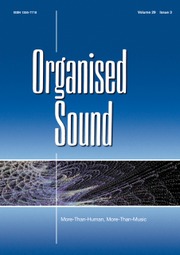No CrossRef data available.
Article contents
The OREMA Project: A call for the liberation of sound analysis
Published online by Cambridge University Press: 16 November 2015
Abstract
Following Edgard Varèse’s influential lectures –translated and documented in ‘The Liberation of Sound’– electroacoustic music has spawned many different styles and genres.His argument was for composers to follow their imagination and not be bound tothe constraints of musical notation. This, arguably, was one of the catalystsfor the emergence of electroacoustic musical works. With past and recenttechnological advancement, the varieties of genres and styles withinelectroacoustic music have only expanded, challenging the notion of how onecould analyse such works. It is therefore unsurprising that there is no generalconsensus on analytical methodologies. But for an art form that celebrates allmusical possibilities should the analysis of such musics be constraint to a setnumber of formalised analytical methodologies?
Rather than propose a new all-encompassing methodology, this article will arguefor a universal approach to electroacoustic music analysis and the liberation ofsound analysis. The concept of an analytical community (a community that acceptsmultiple analyses whilst encouraging practitioners to find new and innovativeways to analyse such works) will be raised as a means to address the issuesfacing electroacoustic music analysis, using the OREMA (Online Repository forElectroacoustic Music Analysis) project as an example of such an initiative.
- Type
- Articles
- Information
- Organised Sound , Volume 20 , Issue 3: Aesthetic Radicalism, Future and Past , December 2015 , pp. 316 - 322
- Copyright
- © Cambridge University Press 2015


